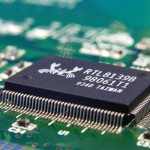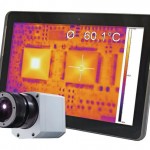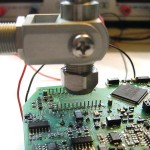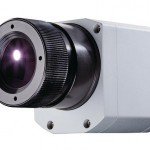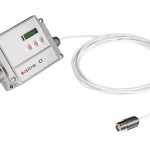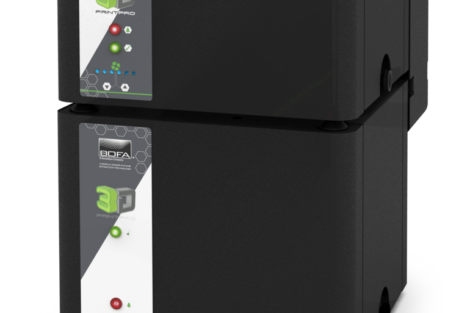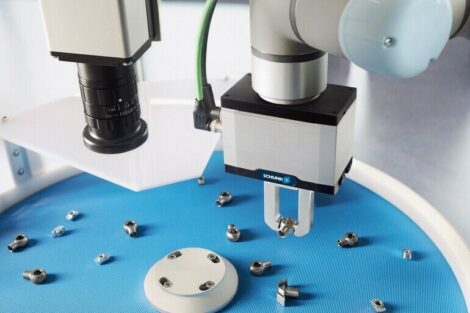More and more manufacturers of electronic components and circuit boards turn to the use of non-contact temperature measurement due to the increasing productivity of their components. The thermal behavior can be captured and optimized through the use of modern infrared measurement devices – without influencing the measuring object.
Optris GmbH, Berlin (Germany)
Infrared cameras are used for accurate thermal analysis on electronic components, e.g. in cases here not only one critical component exists or the component can not be clearly defined. Weak oints can be localized by the camera through the demonstration of thermal images.
Real time analysis
A detailed real time analysis of the thermal behavior of assembled circuit boards, used in the R&D field or for serial production, can be achieved through the assistance of an infrared thermal imager. The standardized USB2.0 interface allows video recording up to 120 Hz. This is extremely advantageous for thermal activities which only emerge in short terms and need to be analyzed in slow motion afterwards. Individual pictures can be taken out of such recordings including all geometric and thermal resolution.
The analysis takes place via an efficient software which offers any measure points and user defined rectangles. Alarms can be defined and displayed as well as maximum, minimum and average temperatures. Besides the recording function, the software also offers the possibility to record and save snapshots. The adaption of the camera software for industrial control is standard.
The thermal imager optris PI consists of 382 x 288 or rather 110.016 miniaturized single detectors as a matrix on one chip (Focal Plane Array, FPA). This uncooled microbolometer FPA detector is the image-guided component.
Bolometers are a sub-group of thermal detectors. They stand out through the temperature resistance of their electrical resistor. During the absorption of heat radiation through the sensitive element, the change in resistance calls for a change of the dropping signal voltage via the bolometer resistance. Fast 14 bit A/D converter digitizes the increased and serialized video signal. A digital signal processing calculates a temperature for each pixel and generates the familiar false color image in real time. An adjustment to different measurement distances and measurement sizes is achieved through the combina-tion of the micro bolometer FPA detector and the high performance optic. Thermal processes of very small objects starting from a size of 75µm (e.g. smallest SMD components for function tests) are presentable due to small pixel sizes at the detector. Starting from a size of 25 µm the temperature of the elements can be measured exactly. The excellent thermal sensitivity of the camera of 40mK allows the display of fine temperature details.
It does not always need to be a camera
Due to high production numbers and the large amount of test stations, the use of infrared cameras can be too expensive. Temperature monitoring with infrared thermometers is a good alternative for series production control of critical components within production facilities. Critical components which can repeatedly be placed within the series production due to their measuring point (position on the circuit board) will be monitored via the infrared temperature sensor optris CT LT. The temperature measurement result is forwarded to the test station routine for decision making.
Miniaturized IR thermometer
Modern production technology not only enabled price reductions within the production process, it also established the multiple uses of infrared thermometers within equipment. The miniaturized infrared thermometers optris CT LT are used for practical applications such as the checking of assembled circuit boards. They are one of the worldwide smallest measuring infrared temperature sensors with a linear output covering the complete temperature range from –50 to 975°C.
The small sensor consists of a miniature infrared sensing head (14 mm x 28 mm) and a seperate electronic box. The small size of the infrared sensing head allows the implementation in cramped surrounding areas and is therefore particularly suitable for test stations which disclaimed the use of non-contact temperature measurement due to lack of space. The sensing head comes with a stainless steel housing (IP65) which is robust and intended for the use in sur-rounding temperatures up to 180°C without additional cooling. An accurate resolutory optic with a distance-to-measurement-point-proportion of 22:1 allows a flexible choice regarding the installation point within the test station. An additional innovation is the possibility to measure smallest spot size from 0.6 mm due to a small ancillary lens.
The evaluation electronic (IP65) offers multiple signal processing methods. The measured temperature signal of the circuit board is made available to the operator via linear 0–20 mA, 4–20 mA, 0–10 V or thermocouple-output. An included control panel with LCD display allows the choice of the signal processing method as well as the parameter adjustment at the assembly area. The programming can take place through an included USB or RS232 interface, supported by a PC or Laptop-PC. For the implementation of existing data, different addressable interfaces are available, such as a RS485 interface or CAN-Bus, Profibus DP, Ethernet and alarm relays.
ZUSAMMenfassung
Zunehmend setzen Hersteller elektronischer Bauelemente und Leiterplatten wegen der stetig höher werdenden Leistungsfähigkeit ihrer Bauelemente auf die berührungslose Temperaturmessung. Durch den Einsatz moderner Infrarot-Messgeräte lässt sich das thermische Verhalten in kurzer Zeit erfassen und optimieren, ohne dass das Messobjekt beeinflusst wird.
De plus en plus, les fabricants d’éléments de construction électroniques et de circuits imprimés mettent l’accent sur la mesure de température sans contact à cause de la capacité conductrice toujours plus élevée de leurs éléments de construction. Grâce à la mise en œuvre d’appareils de mesure modernes à infrarouges, le comportement thermique peut être saisi et optimisé en très peu de temps, sans que l’objet de la mesure ne subisse d’influence.
Share:


